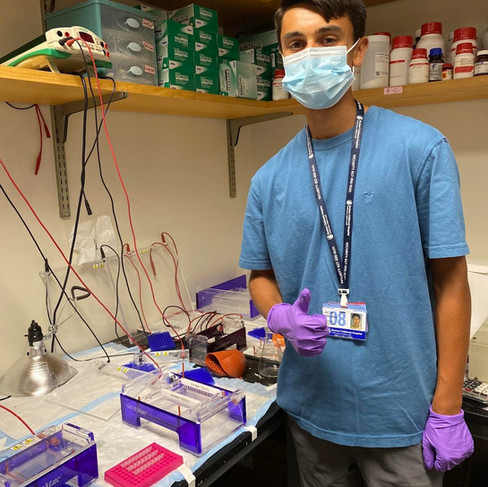This summer, I was fortunate enough to intern at the Burns Lab at Boston Children’s Hospital. The Burns Lab is a cardiology lab that studies heart development, heart failure, cardiomyopathy, and heart regeneration. The lab primarily uses zebrafish to model human heart diseases. In addition, they use mice and human iPSCs (stem cells) which are more expensive but often more applicable to patients. Many of the projects in the lab, including mine, focus on identifying and characterizing genetic pathways that cause either structural or functional phenotypes in the heart.
I worked directly with two trainees in the Burns lab, Dr. Alex Akerberg, a postdoctoral fellow, and Celia Harding, a research assistant and the lab manager, on a project Alex has been working on for the past several years. Alex discovered that RBPMS2, a highly conserved RNA binding protein, is an essential regulator of heart function in zebrafish and human iPSC-derived cardiomyocytes (heart cells). Specifically, Alex found that a mutation in RBPMS2 leads to cardiac edema (swelling of the heart) and heart failure in zebrafish. He found that sarcomeres in the heart, which are responsible for muscle contraction, are not assembled properly in RBPMS2 mutants.
RBPMS2 has a protein domain that binds to RNA during RNA splicing. RNA splicing is the process in which sections of a transcript are removed (introns) from pre-mRNA to make mRNA where the remaining sections (exons) are pieced together. In addition to pre-mRNA splicing, alternative splicing can also occur where transcripts in different cell types can be differentially spliced so that the mRNA is composed of different exons. Alex found that RBPMS2 is only expressed in cardiomyocytes and creates over one hundred alternatively spliced transcripts in these cells. Several of these alternatively spliced genes are known to cause cardiomyopathy in humans when they are mutated.
My work helped determine if these alternatively spliced genes are responsible for the defects we see in RBPMS2 mutant zebrafish. I focused on a single gene, mybpc3. This transcript showed the most significant change in RBPMS2 mutants and lacked exons 2 and 10 in mRNA, which were both present in wild-type control. We wanted to know if the misspliced mybpc3 was what causes the heart defects we observed. To do this, Alex isolated the mybpc3 mutation in zebrafish using CRISPR-Cas9 genome editing to alter the fish’s DNA. The first week consisted of breeding the adult fish and collecting their offspring. Specifically, we would set up a mating pair of fish overnight with the male and female separated by a divider. Then we would remove the dividers in the morning and wait for the fish to lay embryos. We collected all the embryos from the fish that laid embryos and brought them up to the lab.
I first wanted to confirm that the mybpc3 mutant fish had the same misspliced RNA (without exon 2) as the RBPMS2 mutants. To do this, Celia and I extracted the RNA from the embryos and created complementary DNA (cDNA) that we could use for our analysis. With cDNA, we ran quantitative PCR , which quantifies the amount of a specific cDNA sequence that we can detect using gene-specific primers and dyes. This test allowed us to quantify the amount of mybpc3 with exon 2, the amount of total mybpc3 transcript (independent of exon 2), and rsp11 (a standard gene used for normalization). Using a ∆∆CT calculation, we analyzed our data from 3 mybpc3 homozygous mutant samples and 3 controls samples. Our results showed that the CRISPR worked correctly by removing exon 2 in mybpc3 mutants while (mostly) maintaining normal levels of total mybpc3 RNA. Our next step was to use immunofluorescence to determine if the sarcomeres were assembled properly in mybpc3 mutants. Although I was able to run the immunofluorescence experiment and take confocal images of the zebrafish hearts, the procedure led to inconclusive results that I did not have time to repeat before the end of my internship.
We also wanted to learn whether the cardiac defects in RBPMS2 mutants were caused by a combination of alternatively spliced genes. Alex used CRISPR-Cas9 to generate splicing mutants in mybpc3, pln, myom2a, and slc8. I genotyped 24 fish to find animals carrying a mutant allele in all four genes. To genotype the fish, I clipped a piece of the fin and extracted the DNA. I then used primers to run a PCR that would allow us to distinguish a wildtype allele from a mutant allele for each gene based on size. To see the size of each DNA fragment, I ran the PCR reaction on an agarose gel. After analyzing the results, we were unable to find any fish that were mutant for all four genes. However, we did identify two fish where 2 of the genes were mutant and the other two were heterozygous (+/-). We set up these fish to breed.
In addition to my wet bench work, the other interns and I met for a journal club with Dr. Vassilious Bezzerides every Thursday. To prepare for these journal clubs, we would read assigned scientific articles, and each of us would dissect a certain section or figure. It was hard to understand the articles at first, especially with all the figures and charts, but we were able to learn quickly how to break down the articles and analyze the graphs.
Abby and I also had a clinical experience with Dr. Bezzerides where we performed inpatient rounds and visited the ORs. We visited some patients that were staying in the hospital with heart problems. We were also able to watch surgery on a patient with mixed aortic valve disease. We were able to learn more about the clinical side of the hospital from someone who has experience with both experimental research and clinical work.
I found my entire experience at The Burns Lab extremely interesting and I was able to learn so much over the course of the internship. I not only learned a lot about genetics, hearts, and zebrafish but I also learned a lot about labs and scientific research in general. I learned the importance of consistency. When performing qPCR we had to make sure every sample was identical down to the last microliter. I also learned a lot about how statistics are used in research. This was especially evident in the scientific papers but also in our work analyzing the genes of each fish and comparing how many mutant fish we expect versus how many we observe. Another large part of the research experience is handling unexpected results. There were several times when the results we got were inconsistent with the results we expected either due to contamination or incorrect genotyping. When this happened Alex, Celia, and I would meet to find our sources of error and make a plan to improve our results. Eventually, through trial and error, we were able to improve our experiment methods and get better results.

Lastly, I would like to thank everyone at the lab especially Alex, Celia, Dr. Caroline Burns, and Dr. Geoff Burns. The internship helped me cultivate even more interest in this line of work and it wouldn’t have been the same without their outstanding guidance. I would also like to thank Mr. Schlenker for helping set up the internship and connecting me with Caroline and Geoff. I really enjoyed this experience and cannot thank you all enough.
















Comments